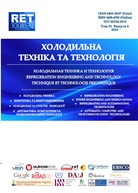ДОСЛІДЖЕННЯ ЕКСЕРГОЕФЕКТИВНОСТІ ТА ШЛЯХІВ ЕНЕРГОЗБЕРЕЖЕННЯ СИСТЕМИ КОНДИЦІЮВАННЯ ПОВІТРЯ ОПЕРАЦІЙНИХ ЧИСТИХ КІМНАТ
DOI:
https://doi.org/10.15673/0453-8307.4/2015.48627Ключові слова:
Cистеми кондиціювання повітря, Чисті кімнати, Ексергетичний баланс, Ексергетична ефективність, ЕнергозбереженняАнотація
У статті наведений аналіз ексергоефективності впровадженої центральної прямотечійної системи кондиціювання повітря (СКП) операційних чистих кімнат, отриманий на її інноваційній математичній дослідницькій моделі залежно від різних факторів, що впливають на її роботу, та запропоновані шляхи енергозбереження для цієї СКП. Встановлено, що найбільший вплив на ексергетичний ККД цієї системи кондиціювання мають різниця температур між внутрішнім і припливним повітрям у приміщенні, температура внутрішнього повітря, залежна від температури зовнішнього повітря, та коефіцієнт трансформації прийнятої холодильної машини СКП.Посилання
Fedotov A.E. 2003. Chistye pomeshcheniia. Vtoroe izd., pererab. i dop. Moskva: ASINKOM, 2003. 576 (in Russian).
Hayakava I. 1990. Chistye pomeshcheniia. Per. s iaponsk. Moskva: Mir. 456 (in Russian).
Whyte W. 2002. Tekhnologiia chistykh pomeshchenii. Osnovy proektirovaniia, ispytanii i ekspluatatsii. Moskva: Klinrum. 304 (in Russian).
Whyte W. 2004. Proektirovanie chistykh pomeshchenii. Per. s angl. Moskva: Klinrum. 360 (in Russian).
GOST ISO 14644-1. Chistye pomeshcheniia i sviazannye s nimi kontroliruemye sredy. Chast’ 1. Klassifikatsiia chistoty vozdukha (in Russian).
Sokolov, E.Ia., Brodianskii, V.M. 1981. Energeticheskie osnovy transformatsii tepla i protsessov okhlazhdeniia: ucheb. posobie dlia vuzov. 2-e izd., pererab. Moskva: Energoizdat. 320 (in Russian).
Shargut, Ia. , Petela, R. 1968. Eksergiia Moskva: Energiia. 280 (in Russian).
Eksergeticheskie raschety tekhnicheskikh sistem. 1991: sprav. posobie / [V.M. Brodianskii, G.P. Verhivker, Ia.Ia. Karchev i dr.]; pod red. A.A. Dolinskogo, V.M. Brodianskogo; In-t tekhnicheskoi teplofiziki AN USSR. Kiev: Nauk. dumka. 360.
Brodianskii V.M. 1973. Eksergeticheskii metod termodinamicheskogo analiza / V.M. Brodianskii. – Moskva: Energiia. – 296 (in Russian).
Ber G.D. 1977. Tekhnicheskaia termodinamika Moskva: Mir. 518 (in Russian).
Bogoslovskii, V.N., Kokorin, O.Ia., Petrov, L.V. 1985. Konditsionirovanie vozdukha i kholodosnabzhenie: Uchebnik dlia vuzov. Stroiizdat. 367 (in Russian).
Prokhorov, V.I., Shilkloper, S.M. 1981. Metod vychisleniia eksergii potoka vlazhnogo vozdukha. Kholodil’naia tekhnika, No. 9, 37–41 (in Russian).
Shilkloper, S.M., Zhadin, S.I. 1982. Eksergeticheskii analiz sistem obespecheniia mikroklimata i energosnabzheniia. Stroitel’stvo i arkhitektura. Ser. 9, Vyp. 4. , 18–27 (in Russian).
SNiP 2.04.05–86. 1987. Otoplenie, ventiliatsiia i konditsionirovanie. Moskva: TsITP Gosstroia SSSR. 64 (in Russian).
Iantovskii E.I. 1988. Potoki energii i eksergii. Moskva: Nauka. 144 (in Russian).
Bes T. 1962. Egzergia w procesach ogrzewania, klimatyzacji i suszenia. Energetyka Przemysłowa, 10, No. 11, 388–392 (in Polish).
Labai Volodymyr. 2000. Eksergetychna efektyvnist’ tsentral’nykh kondytsioneriv / Volodymyr Labai, Taras Ivanukh // V Konferencja naukowa Rzeszowsko-Lwowsko-Koszycka „Aktualne problemy budownictwa i inżynierii środowiska”. Zeszyty naukowe Politechniki Rzeszowskiej «Budownictwo i inżynieria środowiska». – Z. 32, część 2: Inżynieria Środowiska. – Rzeszów: Politechnika Rzeszowska, 25-26 września. – 229–235 (in Ukrainian).
Labay V. 2014. Innovation model for energy effective investigations of air conditioning systems for cleanrooms / V. Labay, D. Harasym // ECONTECHMOD – Lublin-Rzeszow: 2014 – Vol. 3, № 1. – 47–52 (in English).
Garasym D.І. 2014. Otsiniuvannia system kondytsiiuvannia povitria chystykh prymishchen’ za diagramoiu Grassmana / Garasym D.І., Labay V.I. // Stroitel’stvo, materialovedenie, mashynovedenie: Sb. nauch. trudov. Vyp. № 76. – Dn-vsk: PGASA. – 95–100 (in Ukrainian).
Labai, V.I., Harasym, D.I. 2015. The dependence of the exergetic output-input ratio of air conditioning system for operating cleanrooms on coefficient of transformation of refrigeration machine. Refrigeration engineering and technology, 51(3), 14–21 (in Ukrainian). DOI: 10.15673/0453-8307.3/2015.42636


